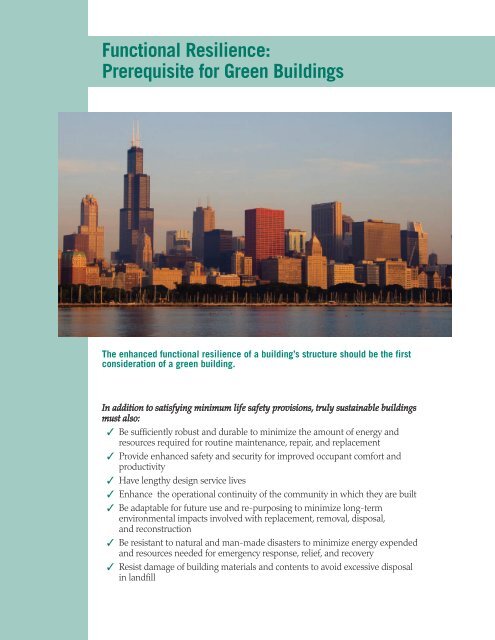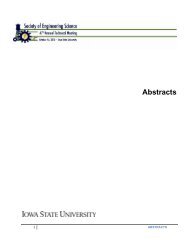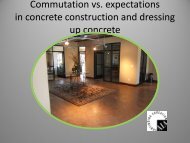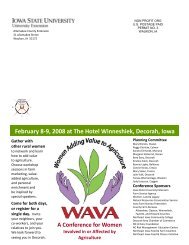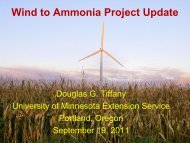Prereq for Green Buildings - Conference Planning and Management
Prereq for Green Buildings - Conference Planning and Management
Prereq for Green Buildings - Conference Planning and Management
You also want an ePaper? Increase the reach of your titles
YUMPU automatically turns print PDFs into web optimized ePapers that Google loves.
Functional Resilience:<br />
<strong>Prereq</strong>uisite <strong>for</strong> <strong>Green</strong> <strong>Buildings</strong><br />
The enhanced functional resilience of a building’s structure should be the first<br />
consideration of a green building.<br />
In addition to satisfying minimum life safety provisions, truly sustainable buildings<br />
must also:<br />
✓ Be sufficiently robust <strong>and</strong> durable to minimize the amount of energy <strong>and</strong><br />
resources required <strong>for</strong> routine maintenance, repair, <strong>and</strong> replacement<br />
✓ Provide enhanced safety <strong>and</strong> security <strong>for</strong> improved occupant com<strong>for</strong>t <strong>and</strong><br />
productivity<br />
✓ Have lengthy design service lives<br />
✓ Enhance the operational continuity of the community in which they are built<br />
✓ Be adaptable <strong>for</strong> future use <strong>and</strong> re-purposing to minimize long-term<br />
environmental impacts involved with replacement, removal, disposal,<br />
<strong>and</strong> reconstruction<br />
✓ Be resistant to natural <strong>and</strong> man-made disasters to minimize energy expended<br />
<strong>and</strong> resources needed <strong>for</strong> emergency response, relief, <strong>and</strong> recovery<br />
✓ Resist damage of building materials <strong>and</strong> contents to avoid excessive disposal<br />
in l<strong>and</strong>fill
Functional Resilience – What <strong>and</strong> Why?<br />
The need <strong>for</strong> increased functional resilience in building design <strong>and</strong><br />
construction has long been recognized by many entities <strong>and</strong> identified<br />
in many publications <strong>and</strong> programs. One of the most noteworthy<br />
programs is the FORTIFIED ® program developed <strong>and</strong> implemented by<br />
the Institute <strong>for</strong> Business <strong>and</strong> Home Safety (IBHS), a national association<br />
representing the insurance <strong>and</strong> re-insurance industries. The FORTIFIED<br />
program focuses on the need <strong>for</strong> more durable <strong>and</strong> more disasterresistance<br />
construction.<br />
However, functional resilience is much more than disaster resistance.<br />
The increased robustness, longevity, <strong>and</strong> durability, combined with<br />
improved disaster resistance result in less energy <strong>and</strong> resources required<br />
<strong>for</strong> repair, removal, disposal, <strong>and</strong> replacement of building materials <strong>and</strong><br />
contents due to routine maintenance <strong>and</strong> operations, as well as disasters.<br />
Functionally resilient buildings create safe, secure, com<strong>for</strong>table, <strong>and</strong><br />
productive environments in which to live <strong>and</strong> work.<br />
Community-Wide Operational Continuity<br />
Source: Federal Emergency <strong>Management</strong> Agency<br />
Flooding not only damages, but typically contaminates<br />
building materials <strong>and</strong> contents rendering them unusable<br />
<strong>and</strong> requiring incineration or disposal in l<strong>and</strong>fills.<br />
The impact of enhanced functional resilience is not limited to buildings. More functionally resilient<br />
buildings can significantly enhance the sustainability of communities. Continuous business operations<br />
<strong>and</strong> residential occupancy provide the economic benefits of a more consistent tax base <strong>and</strong><br />
generally support continuity of the community’s vitality. Further community economic, societal,<br />
<strong>and</strong> environmental benefits result from reductions in resources that would need to be reallocated<br />
<strong>for</strong> emergency response, disaster relief, <strong>and</strong> disaster recovery.<br />
The Missing Link<br />
To date most sustainability or green voluntary certification programs, codes,<br />
<strong>and</strong> st<strong>and</strong>ards have focused primarily on energy, material, <strong>and</strong> water<br />
conservation; indoor environmental quality; <strong>and</strong> site selection <strong>and</strong><br />
development. Each of these is an important aspect of sustainable building<br />
design <strong>and</strong> construction. However, the assumption that the basic building<br />
will be functionally resilient is not inherent in these programs. Often<br />
minimum requirements in many building codes are focused on life safety<br />
<strong>and</strong> do not provide the protection of buildings <strong>and</strong> their contents necessary<br />
<strong>for</strong> truly sustainable buildings. Un<strong>for</strong>tunately, this is consistent with our<br />
disposable-mentality <strong>and</strong> often results in buildings that satisfy the absolute<br />
minimum project requirements at the least possible initial cost. Even<br />
today, many jurisdictions do not have a building code or the building code<br />
may not be applicable to all building occupancies.<br />
Source: Federal Emergency <strong>Management</strong> Agency, photographed by<br />
Greg Henshall<br />
Conflagrations from building fires jeopardize communities.<br />
For example a dormitory under construction at Virginia<br />
Commonwealth University (not depicted here) burnt to<br />
the ground <strong>and</strong> spread fire to 28 surrounding buildings.<br />
1
Functional Resilience: <strong>Prereq</strong>uisite <strong>for</strong> <strong>Green</strong> <strong>Buildings</strong><br />
Championing Functional Resilience<br />
There are many resources <strong>and</strong> references highlighting the need <strong>for</strong><br />
enhanced functional resilience. The following seven references capture the<br />
most significant aspects:<br />
1. A study of FEMA-awarded grants 1 indicates “a dollar spent on<br />
disaster mitigation saves society an average of $4.” The analysis<br />
included some strategies other than enhanced disaster resistance of<br />
buildings. However, more disaster-resistant buildings enhance life<br />
safety; reduce costs <strong>and</strong> environmental impacts associated with repair,<br />
removal, disposal, <strong>and</strong> replacement; <strong>and</strong> reduce the time <strong>and</strong><br />
resources required <strong>for</strong> community recovery.<br />
2. “When Hurricane Katrina made l<strong>and</strong>fall on August 29, 2005, it caused<br />
an estimated $41.1 billion in insured losses across six states, <strong>and</strong> took<br />
an incalculable economic <strong>and</strong> social toll on many communities. Five<br />
years later, the recovery continues <strong>and</strong> some residents in the most<br />
severely affected states of Alabama, Louisiana, <strong>and</strong> Mississippi are still<br />
struggling. There is no question that no one wants a repeat<br />
per<strong>for</strong>mance of this devastating event that left at least 1,300<br />
people dead. Yet, the steps taken to improve the quality of the<br />
building stock, whether through rebuilding or new construction,<br />
call into question the commitment of some key stakeholders to<br />
ensuring that past mistakes are not repeated.” 2 This report indicates<br />
that there is a need to implement provisions to make buildings<br />
more disaster-resistant.<br />
3. The average annual direct property loss due to natural disasters<br />
in the United States exceeds $35,000,000,000. 3 This does not<br />
include indirect costs associated with loss of residences, business<br />
closures, <strong>and</strong> resources expended <strong>for</strong> emergency response <strong>and</strong><br />
management. These direct property losses also do not reflect the<br />
environmental impact due to reconstruction. Functional resilience<br />
will help alleviate the environmental impact <strong>and</strong> minimize both direct<br />
<strong>and</strong> indirect losses from natural disasters.<br />
4. “Climate changes are underway in the United States <strong>and</strong> are<br />
projected to grow. Climate-related changes are already observed in<br />
the United States <strong>and</strong> its coastal waters. These include increases in<br />
heavy downpours, rising temperature <strong>and</strong> sea level, rapidly<br />
retreating glaciers, thawing permafrost, lengthening growing<br />
seasons, lengthening ice-free seasons in the ocean <strong>and</strong> on lakes<br />
<strong>and</strong> rivers, earlier snowmelt, <strong>and</strong> alterations in river flows. These<br />
changes are projected to grow.” 4 The report further identifies that<br />
“Threats to human health will increase. Health impacts of climate<br />
change are related to heat stress, waterborne diseases, poor air<br />
quality, extreme weather events, <strong>and</strong> diseases transmitted by insects<br />
1.<br />
Natural Hazard Mitigation Saves: An Independent Study to Assess the Future Savings from Mitigation Activities<br />
National Institute of Building Sciences Multi-Hazard Mitigation Council - 2005<br />
2.<br />
Five Years Later – Are we better prepared? Institute <strong>for</strong> Business <strong>and</strong> Home Safety – 2010.<br />
3.<br />
National Weather Service Office of Climate, Water <strong>and</strong> Weather Services National Oceanic <strong>and</strong> Atmospheric<br />
Administration (NOAA) – 2010. Data source is the NOAA website [www.weather.gov/os/hazstats.html]<br />
4.<br />
Global Climate Change Impacts in the United States U.S. Global Change Research Program (USGCRP) – 2009.<br />
The USGCRP includes the departments of Agriculture, Commerce, Defense, Energy, Health <strong>and</strong> Human Services,<br />
Interior, State <strong>and</strong> Transportation; National Aeronautic <strong>and</strong> Space Administration; Environmental Protection<br />
Agency; USA International Development; National Science Foundation; <strong>and</strong> Smithsonian Institution.<br />
2<br />
Source: U.S. Geological Survey, Department of the Interior<br />
It is not just in Cali<strong>for</strong>nia. Some of the largest wild fires<br />
occurred in the Southeast <strong>and</strong> South Central United<br />
States <strong>and</strong> as far north as Maine.<br />
Source: Federal Emergency <strong>Management</strong> Agency.<br />
Damage from earthquakes <strong>and</strong> other disasters can render<br />
buildings inhabitable. Further fires after disasters may<br />
have even larger impacts.<br />
Source: United States Geological Survey Photograph by Martin Klimek,<br />
Marin Independent Journal.<br />
Fires following disasters, where power, water, or emergency<br />
response access are unavailable or limited, can<br />
jeopardize entire communities.
Functional Resilience: <strong>Prereq</strong>uisite <strong>for</strong> <strong>Green</strong> <strong>Buildings</strong><br />
<strong>and</strong> rodents. Robust public health infrastructure can reduce the<br />
potential <strong>for</strong> negative impacts.” Key messages in the report on<br />
societal impacts include:<br />
• “City residents <strong>and</strong> city infrastructure have unique vulnerabilities<br />
to climate change. “<br />
• “Climate change affects communities through changes in<br />
climate-sensitive resources that occur both locally <strong>and</strong> at great<br />
distances.”<br />
• “Insurance is one of the industries particularly vulnerable to<br />
increasing extreme weather events such as severe storms, but it<br />
can also help society manage the risks.”<br />
Sustainable building design <strong>and</strong> construction cannot be about<br />
protecting the natural environment without consideration of the<br />
projected growth in severe weather. Minimum codes primarily<br />
based on past natural events are not appropriate <strong>for</strong> truly sustainable<br />
buildings. <strong>Buildings</strong> expected to reduce negative environmental<br />
impact over the long-term must be protected from these extreme<br />
changes in the natural environment. The provisions <strong>for</strong> improved<br />
property protections are necessary to reduce the amount of energy<br />
<strong>and</strong> resources associated with repair, removal, disposal, <strong>and</strong><br />
replacement due to routine maintenance <strong>and</strong> damage from disasters.<br />
Further such provisions reduce the time <strong>and</strong> resources required <strong>for</strong><br />
community disaster recovery.<br />
5. A study by the Brookings Institution 5 projects that “by 2030 we will<br />
have demolished <strong>and</strong> replaced 82 billion square feet of our<br />
current building stock, or nearly one-third of our existing<br />
buildings, largely because the vast majority of them weren't<br />
designed <strong>and</strong> built to last any longer.” Durability, as a component<br />
of functional resilience, can reduce these losses.<br />
6. During panel discussions, a representative of the National <strong>Conference</strong><br />
of State Historic Preservation Officers noted that more robust<br />
buildings erected prior to 1950 tend to be more adaptable <strong>for</strong><br />
reuse <strong>and</strong> renovation. 6 Prior to the mid-1950s, most local<br />
jurisdictions developed their own building code requirements that<br />
uniquely addressed the community’s needs, issues, <strong>and</strong> concerns—<br />
generally resulting in more durable <strong>and</strong> robust construction.<br />
7. “The risks posed by natural hazards to the built environment demonstrate<br />
the need <strong>for</strong> disaster preparedness to assure that buildings<br />
<strong>and</strong> infrastructure are made more resilient <strong>and</strong> respond better<br />
when disaster strikes.” 7 Supporting statements include that in the<br />
first three <strong>and</strong> one-half months of 2010 there were 31 natural disasters<br />
declared in the U.S. <strong>and</strong> insured catastrophic losses in the 2000s<br />
total $138 billion, a 56 percent increase when compared to the<br />
amount in the 1990s. One of the recommendations is: “Encourage<br />
the design community toward greater focus on resilience.”<br />
5.<br />
Sustainable Stewardship - Historic preservation plays an essential role in fighting<br />
climate change, Traditional Building, National Trust <strong>for</strong> Historic Preservation – 2008.<br />
Article by Richard Moe.<br />
6.<br />
Opportunities <strong>for</strong> Integrating Disaster Mitigation <strong>and</strong> Energy Retrofit Programs<br />
Senate Environment <strong>and</strong> Public Works Committee Room, Dirksen Senate Office<br />
Building, Washington, D.C. - 2010<br />
Without power or water supplies after disasters, individuals<br />
resort to open fires <strong>for</strong> light, heating, cooking <strong>and</strong> purifying<br />
water. Such open fires are often not properly contained<br />
furthering the potential <strong>for</strong> even greater disasters.<br />
While typical building codes <strong>and</strong> st<strong>and</strong>ards are based on<br />
previous weather events <strong>and</strong> disasters, the National<br />
Weather Service is advising that due to global warming we<br />
should expect more extreme <strong>and</strong> severe weather.<br />
Source: Federal Emergency <strong>Management</strong> Agency, taken by Andrea<br />
Booher of FEMA.<br />
Impact of disasters is often beyond the damaged buildings.<br />
During this flood FEMA provided much needed<br />
financial assistance <strong>and</strong> ensured that fresh water, food,<br />
shelter <strong>and</strong> communications were available. After this<br />
flood a total of 534 counties in nine states were declared<br />
<strong>for</strong> federal disaster aid <strong>and</strong> 168,340 people registered <strong>for</strong><br />
federal assistance.<br />
7.<br />
Designing <strong>for</strong> Disaster: Partnering to Mitigate the Impact of Natural Disasters -<br />
Insights Drawn from the National Building Museum’s Industry Council <strong>for</strong> the Built<br />
Environment, May 12, 2010 - Executive Summary<br />
3
Functional Resilience: <strong>Prereq</strong>uisite <strong>for</strong> <strong>Green</strong> <strong>Buildings</strong><br />
The total environmental impact of insulation, high efficiency equipment,<br />
components, <strong>and</strong> appliances, low-flow plumbing fixtures, <strong>and</strong> other<br />
building materials <strong>and</strong> contents are relatively insignificant when rendered<br />
irreparable or contaminated <strong>and</strong> must be disposed of in l<strong>and</strong>fills after<br />
disasters. The US Army Corps of Engineers estimated that after Hurricane<br />
Katrina nearly 1.2 billion cubic feet of building materials <strong>and</strong><br />
contents ended up in l<strong>and</strong>fills. This is equivalent to a b<strong>and</strong> of refrigerators<br />
placed end to end twice around the equator of the Earth.<br />
DESIGN FOR FUNCTIONAL RESILIENCE<br />
BASIS FOR THE CRITERIA<br />
Functional resilience as presented here is modeled after the concepts of the<br />
Whole Building Design Guide developed jointly by the National Institute<br />
of Building Sciences <strong>and</strong> the Sustainable Building Industries Council. For<br />
building design <strong>and</strong> construction the Whole Building Design Guide<br />
addresses:<br />
Design of buildings should appropriately consider longterm<br />
community development plans to help assure buildings<br />
can be re-used or re-purposed.<br />
Accessible<br />
Aesthetics<br />
Cost-effective<br />
Functional / Operational<br />
Historic Preservation<br />
Productive<br />
Secure / Safe<br />
Sustainable<br />
The minimum requirements are set to be consistent with the design <strong>and</strong><br />
construction requirements identified in the Institute <strong>for</strong> Business <strong>and</strong><br />
Home Safety FORTIFIED ® programs. The design <strong>and</strong> construction strategies<br />
presented are material-neutral. There are a few exceptions, similar to<br />
the requirements in current building codes, such as limiting construction<br />
below flood elevation to treated wood, concrete, or masonry.<br />
Source: U.S. Department of Energy<br />
Robust, disaster resistant, buildings with long lives <strong>and</strong><br />
low maintenance minimize the contribution of the built<br />
environment to l<strong>and</strong>fills.<br />
ENVIRONMENTAL BENEFITS<br />
There are many benefits related to the enhanced functional resilience of buildings. In addition to<br />
long-term environmental benefits, other benefits are better buildings <strong>for</strong> occupant safety, com<strong>for</strong>t,<br />
<strong>and</strong> productivity; property protection – both building <strong>and</strong> building contents; economic benefits <strong>for</strong><br />
the building occupants, owners, <strong>and</strong> the community; <strong>and</strong> societal benefits related to operational<br />
continuity <strong>for</strong> the community. The significant direct environmental benefits include reduced<br />
dem<strong>and</strong> <strong>for</strong> resources <strong>and</strong> less energy expenditures required <strong>for</strong>:<br />
1. Repair, removal, disposal <strong>and</strong> replacement of building elements due<br />
to normal operations <strong>and</strong> maintenance;<br />
2. Building demolition <strong>and</strong> replacement resulting from increased adaptability<br />
<strong>for</strong> re-use <strong>and</strong> even re-purposing;<br />
3. Repair, removal, disposal <strong>and</strong> replacement of building elements <strong>and</strong><br />
building contents when disasters occur; <strong>and</strong><br />
4. Emergency response, relief <strong>and</strong> recovery when disasters occur.<br />
Source: Federal Emergency <strong>Management</strong> Agency, taken by Michael Rieger<br />
of FEMA.<br />
During <strong>and</strong> after disasters, huge amounts of energy <strong>and</strong><br />
resources are expended <strong>for</strong> emergency response, disaster<br />
relief, <strong>and</strong> community recovery.<br />
4
Functional Resilience: <strong>Prereq</strong>uisite <strong>for</strong> <strong>Green</strong> <strong>Buildings</strong><br />
USE OF THE RECOMMENDATIONS<br />
These recommendations are intended to provide enhancements to basic minimum building code<br />
requirements. They are offered to help designers lessen the environmental footprint of the building<br />
core <strong>and</strong> shell. As previously mentioned the recommendations are modeled after the concepts of<br />
the Whole Building Design Guide <strong>and</strong> are consistent with the criteria of the FORTIFIED ® programs.<br />
Thus, <strong>for</strong> the design <strong>and</strong> construction of green or sustainable buildings, they are presented as<br />
enhancements to minimum building code <strong>and</strong> are intended <strong>for</strong> buildings with design service lives<br />
of 50 to 60 years. The American Society <strong>for</strong> Heating Refrigerating <strong>and</strong> Air-Conditioning Engineers<br />
(ASHRAE) St<strong>and</strong>ard <strong>for</strong> the Design of High-Per<strong>for</strong>mance <strong>Green</strong> <strong>Buildings</strong> Except<br />
Low-Rise Residential <strong>Buildings</strong> provides <strong>for</strong> a design service life of 50 years. The design service life<br />
in draft ASTM International st<strong>and</strong>ards <strong>and</strong> International Code Council International <strong>Green</strong><br />
Construction Code Public Version 2.0 is 60 years. Naturally, further enhancements than those<br />
provided here may be appropriate to achieve the functional resilience commensurate with longer<br />
design service lives <strong>for</strong> buildings.<br />
<br />
<br />
<br />
<br />
<br />
<br />
<br />
<br />
<br />
<br />
<br />
<br />
<br />
<br />
<br />
<br />
<br />
<br />
<br />
<br />
<br />
<br />
<br />
<br />
<br />
<br />
<br />
<br />
<br />
<br />
<br />
<br />
<br />
<br />
<br />
<br />
<br />
5
Functional Resilience: <strong>Prereq</strong>uisite <strong>for</strong> <strong>Green</strong> <strong>Buildings</strong><br />
SCOPE OF RECOMMENDATIONS<br />
There are many programs, codes, <strong>and</strong> st<strong>and</strong>ards addressing the design <strong>and</strong><br />
construction of green, high-per<strong>for</strong>mance or sustainable buildings. To date,<br />
the scopes of these documents are limited to energy, water <strong>and</strong> materials<br />
resource conservation <strong>and</strong> management; indoor environmental quality;<br />
<strong>and</strong> site selection <strong>and</strong> development. The recommendations presented here<br />
are intended to be combined with those important aspects of design to<br />
further reduce the long-term environmental footprint of new buildings.<br />
Detailed criteria that combine functional resilience with the other key<br />
aspects related to the design <strong>and</strong> construction of green buildings are<br />
presented as a compilation of modifications to the International Code<br />
Council International Building Code on the Portl<strong>and</strong> Cement Association<br />
website as High-Per<strong>for</strong>mance Building Requirements <strong>for</strong> Sustainability<br />
(HPBRS). The HPBRS: (1) are written in m<strong>and</strong>atory language to facilitate<br />
compliance <strong>and</strong> en<strong>for</strong>cement; (2) presented as modifications to the International<br />
Building Code <strong>for</strong> easy adoption; (3) avoid complexities <strong>and</strong><br />
potential misinterpretations associated with multiple compliance alternatives;<br />
(4) limit the provisions <strong>for</strong> traditionally accepted sustainability<br />
features [i.e. energy, water, <strong>and</strong> material conservation <strong>and</strong> management;<br />
indoor environmental quality; <strong>and</strong> site development] to those within the<br />
purview of the typical building code department; (5) combine criteria <strong>for</strong><br />
functional resilience with those <strong>for</strong> the traditionally accepted sustainability<br />
features. The result is a uniquely comprehensive package <strong>for</strong> the design<br />
<strong>and</strong> construction of green buildings. The HPBRS provide <strong>for</strong> functional<br />
resilience <strong>and</strong> are intended to be used with <strong>and</strong> compliment other sustainable,<br />
green, or high-per<strong>for</strong>mance building programs.<br />
Robust, functionally resilient buildings are frequently reused<br />
<strong>and</strong> even re-purposed when downtowns are renovated.<br />
The majority of the recommendations apply to building core <strong>and</strong> shell <strong>and</strong><br />
address building components <strong>and</strong> systems that can be difficult or cost<br />
prohibitive to upgrade or strengthen once the building is occupied. While<br />
each of the criteria discussed may satisfy multiple aspects of enhanced<br />
functional resilience, they are presented in these main categories:<br />
• Service Life - Design service life criteria addressing durability, longevity,<br />
re-use, <strong>and</strong> adaptability.<br />
• Structural Components - Enhanced structural load resistance addressing fire, flooding, frost,<br />
snow loads, wind loads, seismic loads, <strong>and</strong> storm shelters in high wind areas.<br />
• Fire Protection Components - Enhanced protection related to internal structure fires<br />
addressing automatic sprinkler systems, fire containment, <strong>and</strong> potentially hazardous conditions<br />
created where recyclables are collected <strong>and</strong> stored.<br />
• Interior Components – Increased acoustical com<strong>for</strong>t <strong>and</strong> reduction of damage where moisture<br />
may be present.<br />
• Exterior Components - Enhanced protection related to exterior finishes <strong>and</strong> systems used to<br />
clad the building – addressing wind, impact, fire, rodent infestation, <strong>and</strong> radon entry resistance.<br />
The following recommendations <strong>for</strong> enhanced functional resilience are presented <strong>for</strong> consideration<br />
in the design <strong>and</strong> construction of buildings where the minimum requirements of the local building<br />
code or the International Building Code, whichever is more stringent, are satisfied.<br />
Discussion on intent is provided with specific design <strong>and</strong> construction recommendations.<br />
Resources are cited in the end notes to this document.<br />
Enhanced functional resilience lends to reusing or<br />
even re-purposing rather than disposal due to<br />
premature collapse.<br />
6
Functional Resilience: <strong>Prereq</strong>uisite <strong>for</strong> <strong>Green</strong> <strong>Buildings</strong><br />
SERVICE LIFE<br />
DESIGN SERVICE LIFE<br />
Intent – High-per<strong>for</strong>mance building designs should address building<br />
longevity with low operation <strong>and</strong> maintenance costs throughout the life of<br />
the building. A design service life plan helps the designer <strong>and</strong> owner to<br />
evaluate the long-term per<strong>for</strong>mance of the building <strong>and</strong> ensures the<br />
choice of materials <strong>and</strong> building systems minimize long-term costs <strong>for</strong><br />
repair, maintenance, <strong>and</strong> replacement. Earlier discussions identify that the<br />
more robust buildings designed <strong>and</strong> constructed prior to the 1950s are<br />
often more adapatable <strong>for</strong> reuse <strong>and</strong> renovation. This observation is rein<strong>for</strong>ced<br />
by a Brookings Institution study which suggests recently constructed<br />
buildings tend to be more disposable <strong>and</strong> are being replaced rather than<br />
renovated or reused.<br />
Design <strong>and</strong> Construction C, I, M – The design service life of a building<br />
should be no less than 50 years. The general recommendations are that<br />
the design service life of some components may be less than that of the<br />
building. The design service life of structural components, concealed<br />
materials, <strong>and</strong> materials <strong>and</strong> assemblies where replacement is deemed<br />
impractical or cost prohibitive should have a design service life equal to<br />
that of the building. The minimum design service life <strong>for</strong> materials <strong>and</strong><br />
assemblies identified as major is 40 years. Roofing materials <strong>and</strong> systems<br />
are recommended to have a design service life of not less than 20 years.<br />
Mechanical, plumbing, <strong>and</strong> electrical equipment <strong>and</strong> systems are typically<br />
recommended to have a design service life of not less than 25 years, <strong>and</strong><br />
typically hardscape components should have a design service life of at<br />
least 30 years. Further enhancements <strong>for</strong> functional resilience than those<br />
presented here may be appropriate where the design service lives of<br />
buildings exceed 50 years.<br />
Source: City of Atlanta<br />
Image courtesy of the Ellis Hotel,<br />
Atlanta, GA: www.ellishotel.com.<br />
The Winecoff Hotel in Atlanta Georgia was constructed in<br />
1913 <strong>and</strong> completely gutted by fire in 1946. It reopened<br />
as another hotel in 1951 <strong>and</strong> subsequently was used as<br />
housing <strong>for</strong> elderly. After being left vacant <strong>for</strong> 20 years it<br />
reopened as the luxury Ellis Hotel in 2007.<br />
STRUCTURAL COMPONENTS<br />
FIRE DAMAGE RESISTANCE<br />
Intent - To increase the overall robustness of buildings <strong>and</strong> reduce environmental<br />
impacts related to fire, smoke, suppression operations, <strong>and</strong> emergency<br />
response.<br />
Image courtesy of Multifamily Investor: www.multifamilyinvestor.com.<br />
Several buildings adjacent to the collaping World Trade<br />
Center Towers were damaged by falling debris <strong>and</strong> uncontrolled<br />
fires, <strong>and</strong> either collapsed or needed to be demolished.<br />
The office building commonly referred to as 90<br />
West, built in 1907 was damaged by debris <strong>and</strong> sustained<br />
uncontrolled fires <strong>for</strong> five days. It reopened as an apartment<br />
building in 2005.<br />
Fire Losses in the United States During 2009 by the National Fire Protection Association, August<br />
2010 shows that property loss due to structure fires in buildings other than one- <strong>and</strong> two-family<br />
dwellings was approximately $4.5 billion. Increased fire resistance of building elements reduces<br />
the amount of damage to the building <strong>and</strong> its contents. This enhances sustainability by<br />
minimizing building materials required to restore the building <strong>and</strong> reducing the amount of<br />
materials entering l<strong>and</strong>fills. Additional benefits are enhanced life safety, potentially less dem<strong>and</strong><br />
on community resources, especially <strong>for</strong> emergency response, <strong>and</strong> facilities that are more readily<br />
adaptable <strong>for</strong> re-use.<br />
There are many examples of where noncombustible fire resistive construction as defined by the<br />
building code has provided exceptional per<strong>for</strong>mance in fire events, allowing buildings to be re-used<br />
<strong>and</strong> often re-purposed. Two such examples are the Winecoff/Ellis Hotel in Atlanta <strong>and</strong> 90 West<br />
Street in New York City.<br />
7
Functional Resilience: <strong>Prereq</strong>uisite <strong>for</strong> <strong>Green</strong> <strong>Buildings</strong><br />
Design <strong>and</strong> Construction G, M - <strong>Buildings</strong> should be designed so that all<br />
structural load-bearing elements (i.e. walls, columns, beams, girders, floors<br />
<strong>and</strong> roofs) have a fire resistance rating of not less than 1-hour, <strong>and</strong> as the<br />
building size increases in height or area the fire resistance of the structural<br />
components need to increase accordingly. These enhanced fire resistance<br />
features should be implemented in the building design independent of<br />
other fire protection design features such as automatic sprinklers. The fire<br />
resistance rating of structural elements should not be reduced or building<br />
height or area increased simply because sprinklers are present.<br />
FLOOD DAMAGE RESISTANCE<br />
Intent - To minimize the amount of building materials <strong>and</strong> contents that<br />
become contaminated or otherwise irreparably damaged by flood water<br />
Further, flood-resistant construction is less likely to generate debris <strong>and</strong><br />
contaminants that pollute the downstream environment.<br />
Source: Federal Emergency <strong>Management</strong> Agency, taken by David Fine<br />
of FEMA<br />
Severe storms <strong>and</strong> floods damage <strong>and</strong> destroy homes <strong>and</strong><br />
businesses.<br />
Design <strong>and</strong> Construction A, B, M - The design <strong>and</strong> construction of buildings<br />
in flood hazard areas, including flood hazard areas subject to high velocity<br />
wave action, should be designed <strong>and</strong> constructed in accordance with<br />
ASCE 7 A <strong>and</strong> ASCE 24 B <strong>and</strong> the following criteria:<br />
Where required by ASCE 24 B to be built above the base elevations, floors<br />
<strong>and</strong> their lowest horizontal supporting members should not be less than<br />
the higher of:<br />
• Design flood elevation<br />
• Base flood elevation plus 3 feet (1 m)<br />
• Advisory base flood elevation plus 3 feet (1 m) or<br />
• 500-year flood if known<br />
Source: Federal Emergency <strong>Management</strong> Agency, taken by Michael<br />
Rieger of FEMA<br />
The levee in the <strong>for</strong>eground though topped with s<strong>and</strong>bags<br />
still breeched.<br />
Additionally, levees <strong>and</strong> flood walls designed as protective works should<br />
not be considered as providing flood protection.<br />
Robustness of foundations can also be enhanced by following the design<br />
parameters located in Coastal V Zones <strong>and</strong> applying them to foundations<br />
built in the adjacent Coastal A Zones. Increasing the robustness of foundations<br />
in Coastal A Zones reduces the likelihood that the buildings <strong>and</strong><br />
contents will be subject water damage.<br />
Source: Federal Emergency <strong>Management</strong> Agency, photograph taken by<br />
Liz Roll.<br />
Flood damage isn’t limited to the building, but debris<br />
carried by flood waters damage other buildings <strong>and</strong> the<br />
environment.<br />
8
Functional Resilience: <strong>Prereq</strong>uisite <strong>for</strong> <strong>Green</strong> <strong>Buildings</strong><br />
EARTHQUAKE DAMAGE RESISTANCE<br />
Intent - To reduce the amount of damage when earthquakes occur.<br />
Increasing the stringency of the design criteria of high-per<strong>for</strong>mance buildings<br />
<strong>for</strong> earthquakes enhances a buildings ability to respond to a ground<br />
motion event. This results in more durable buildings which reduces<br />
damage to the building <strong>and</strong> its contents from seismic events.<br />
Design <strong>and</strong> Construction A,G,M - <strong>Buildings</strong> in high seismic risk areas<br />
should be designed by a registered design professional. The seismic load<br />
applied to the building design, determined in accordance with IBC G ,<br />
should be increased by at least a factor of 1.2 when located where the 0.2<br />
second spectral response acceleration parameter is equal to or greater than<br />
0.4g. In addition, <strong>for</strong> high seismic risk buildings a site specific geotechnical<br />
report complying with the provisions of ASCE 7 A should be provided.<br />
Source: Federal Emergency <strong>Management</strong> Agency<br />
Earthquake damage to personal property.<br />
This recommendation is consistent with the criteria of the Institute <strong>for</strong><br />
Business <strong>and</strong> Home Safety FORTIFIED ® program.<br />
SNOW LOAD DAMAGE RESISTANCE<br />
Intent - To reduce building damage from excessive snow loads. The<br />
National Weather Service reports that U.S. property damage due to winter<br />
storms <strong>and</strong> ice exceeded $1.5 billion in 2009. Increasing the stringency of<br />
the design criteria <strong>for</strong> snow hazards results in more robust buildings with<br />
less risk of damage. Enhanced sustainability is achieved by minimizing the<br />
amount of both replacement materials required to restore the building <strong>and</strong><br />
damaged materials entering l<strong>and</strong>fills<br />
Design <strong>and</strong> Construction A, G, M - The ground snowloads used <strong>for</strong> sustainable<br />
buildings should be equal to no less than 1.2 times the ground<br />
snowloads determined in accordance with ASCE 7 A or the International<br />
Building Code.<br />
Source: Federal Emergency <strong>Management</strong> Agency<br />
A magnitude 6.7 earthquake caused 72 deaths <strong>and</strong><br />
destroyed or damaged 114,000 residential <strong>and</strong> commercial<br />
buildings. The direct cost of damage alone was estimated<br />
by FEMA to be 25 billion dollars.<br />
STORM SHELTERS<br />
Intent - To require storm shelters <strong>for</strong> enhanced life safety of building occupants.<br />
Minimizing injuries <strong>and</strong> related health costs preserves the human<br />
component of the community <strong>and</strong> permits more rapid recovery after disasters.<br />
These shelters are havens <strong>for</strong> protecting people from injury or death<br />
due to structural collapse <strong>and</strong> impact from windborne debris.<br />
Design <strong>and</strong> Construction A, G, H, M - Storm shelters complying with the<br />
requirements of ICC 500 H should be provided <strong>for</strong> occupants of all sustainable<br />
buildings in hurricane-prone <strong>and</strong> tornado-prone areas where the<br />
shelter design wind speed is 160 mph or more. When combined hurricane<br />
<strong>and</strong> tornado shelters are needed the more stringent requirements of<br />
ICC 500 H should be used.<br />
Source – Institute <strong>for</strong> Business <strong>and</strong> Home Safety<br />
In many instances roof collapse due to snow loads not<br />
only results in damage to roof <strong>and</strong> building contents<br />
below but may also remove lateral support, allowing walls<br />
to collapse.<br />
Source: Oklahoma Department of Emergency <strong>Management</strong><br />
Storm shelters <strong>and</strong> safe rooms really work.<br />
9
Functional Resilience: <strong>Prereq</strong>uisite <strong>for</strong> <strong>Green</strong> <strong>Buildings</strong><br />
WIND DAMAGE RESISTANCE<br />
Intent - To assure enhanced life safety <strong>and</strong> to minimize property damage<br />
due to wind loads. The last significant hurricane season in the United<br />
States was in 2005. The American Society of Civil Engineers reported in<br />
Normalized Hurricane Damage in the United States, 1900 – 2005, National<br />
Hazard Review, ASCE 2008, that property damage from hurricanes was<br />
$81 billion in 2005. Increasing the stringency of the design criteria of<br />
buildings from wind hazards results in more robust buildings. The sustainability<br />
benefit from reduced damage includes less l<strong>and</strong>fill building waste<br />
<strong>and</strong> fewer resources needed <strong>for</strong> replacement <strong>and</strong> repair.<br />
Design <strong>and</strong> Construction A, G, M - Wind loads should be determined in<br />
accordance with ASCE 7 A or the IBC G . The design wind pressure, p, <strong>and</strong><br />
design wind <strong>for</strong>ce, F, determined in accordance with ASCE 7 A or IBC G ,<br />
should be based on a design wind speed equal to the basic wind speed (or<br />
locally adopted basic wind speed in special wind zones, if higher) plus 20-<br />
mph. Determine component <strong>and</strong> cladding loads <strong>for</strong> the design wind speed<br />
defined, assuming terrain Exposure C, regardless of the actual local exposure.<br />
Assume wind can come from any horizontal direction <strong>and</strong> wind<br />
pressures to act normal to the surface considered.<br />
Besides the design <strong>for</strong> overall structural resistance to wind loads, additional<br />
attention is needed <strong>for</strong> specific elements associated with the exterior<br />
building envelope, such as the roof <strong>and</strong> wall coverings. Roof coverings <strong>and</strong><br />
their attachment should be subjected to rigorous tests <strong>for</strong> resistance<br />
to the effects of wind following the protocols of nationally recognized<br />
programs such Underwriters Laboratory or FM Global. Where roof coverings<br />
depend on structural sheathing <strong>for</strong> support, give extra attention to the<br />
stiffness of the panels <strong>and</strong> the connections to framing. Vinyl siding, exterior<br />
insulation finishing systems, <strong>and</strong> other lightweight exterior wall covering<br />
materials should not be used as exterior coverings in hurricane <strong>and</strong><br />
tornado prone regions.<br />
Source: Federal Emergency <strong>Management</strong> Agency, photograph taken by<br />
Tim Burkitt of FEMA.<br />
FEMA advises that the storm shelter at this high school<br />
will provide near absolute protection <strong>for</strong> more than 2,000<br />
people in the event of a hurricane or tornado.<br />
Design Wind Speed Map <strong>for</strong> Community Shelters<br />
Source: Federal Emergency <strong>Management</strong> Agency, photograph taken by<br />
Lara Shane of FEMA.<br />
Homes <strong>and</strong> businesses that are not designed <strong>and</strong><br />
constructed to provide an appropriate level of functional<br />
resilience are at greater risk in high wind exposures.<br />
Source: Federal Emergency <strong>Management</strong> Agency, photograph taken by<br />
Greg Henshall of FEMA<br />
The center of a town twelve days after it was hit by an<br />
tornado with 200 mph winds. FEMA reported that debris<br />
removal was moving at a record pace, but reconstruction<br />
would likely take years. Such devastation places a large<br />
strain on the community <strong>and</strong> the environment.<br />
10
Functional Resilience: <strong>Prereq</strong>uisite <strong>for</strong> <strong>Green</strong> <strong>Buildings</strong><br />
FIRE PROTECTION COMPONENTS<br />
AUTOMATIC SPRINKLER SYSTEMS<br />
Intent - To reduce damage due to fire, smoke, <strong>and</strong> suppression operations<br />
<strong>and</strong> enhance life safety. A buiding’s robustness is enhanced by requiring<br />
sprinkler protection. Sprinkler protection <strong>and</strong> other fire safety systems<br />
combined with established fire compartments can reduce damage to the<br />
building <strong>and</strong> its contents from a fire event. Appropriate levels of combined<br />
containment with automatic fire sprinkler systems minimize damage from<br />
fire, smoke, steam, <strong>and</strong> water used <strong>for</strong> suppression <strong>and</strong> control, Further,<br />
the combination reduces the amount of toxic smoke that may be generated<br />
by some building materials <strong>and</strong> building contents when fires occur.<br />
Design <strong>and</strong> Construction G, L, M – All buildings, except low fire-risk manufacturing<br />
<strong>and</strong> storage facilities, should be protected with automatic sprinkler<br />
systems con<strong>for</strong>ming to the NFPA 13 L . The presence of sprinkler<br />
protection reduces the risk of damage to the building from a fire event.<br />
This risk is further reduced when the sprinkler protection is provided in all<br />
spaces of the building including concealed spaces such as open-truss floor<br />
assemblies <strong>and</strong> attics constructed of combustible materials. Because<br />
National Fire Protection Association St<strong>and</strong>ard <strong>for</strong> the Installation of Sprinkler<br />
Systems in Residential Occupancies Up To <strong>and</strong> Including Four Stories in Height<br />
(NFPA 13R). sprinkler systems do not provide sprinkler protection in these<br />
concealed spaces, they should not be used. This enhanced sprinkler<br />
protection <strong>and</strong> compartmentation in residential occupancies will tend to<br />
minimize the portion of the building <strong>and</strong> time <strong>for</strong> which the building<br />
cannot be inhabited.<br />
Source: Northeast Fire Safety Construction Advisory Council<br />
Fire containment achieved with compartmentation<br />
minimizes damage due to fire, smoke, <strong>and</strong> water used<br />
<strong>for</strong> suppression.<br />
St<strong>and</strong>pipe <strong>and</strong> fire alarm system features should not be reduced or modified<br />
based on the presence of automatic sprinkler protection. These additional<br />
fire protection systems in conjunction with sprinkler protection add<br />
to the robustness of the building.<br />
INTERNAL FIRE BARRIERS<br />
Intent - To reduce damage from fire, smoke, suppression, <strong>and</strong> control operations<br />
<strong>and</strong> generallyincrease the robustness <strong>and</strong> durability of the building.<br />
Design <strong>and</strong> Construction G, M - Fire walls are used to create separate<br />
building areas <strong>for</strong> large buildings. They should be constructed entirely of<br />
noncombustible materials; have fire resistance ratings of at least 2-hours;<br />
<strong>and</strong> be constructed in accordance with the IBC G .<br />
To further reduce the risk of fire spread within buildings, provide internal<br />
fire barriers (walls, shafts around floor openings <strong>and</strong> horizontal floor<br />
systems) to establish multiple fire area compartments <strong>and</strong> restrict the<br />
spread of fire between floors of multi-story buildings. Fire barrier assemblies<br />
should be constructed in accordance with the IBC G , have fire resistance ratings of at least<br />
1-hour, <strong>and</strong> not have the fire resistance rating reduced due to the presence of sprinkler protection.<br />
Robustness is also enhanced through compartmentation using fire barriers to separate dwelling<br />
<strong>and</strong> sleeping units as well as separate these spaces from adjacent non-residential areas in residential<br />
occupancies (i.e. hotels, motels, <strong>and</strong> apartments). These fire barriers should have fire resistances<br />
established by the IBC G <strong>for</strong> creating separate fire areas. A compartmentation requirement replacing<br />
fire partitions with fire barriers <strong>and</strong> reduces the risk of fire spread. Such containment also reduces<br />
damage due to smoke <strong>and</strong> suppression operations.<br />
Source: Northeast Fire Safety Construction Advisory Council<br />
Fire resistant non-combustible materials contain fires<br />
minimizing fire <strong>and</strong> smoke damage. This damage<br />
resistance allows portions of the buildings to simply be<br />
cleaned, painted <strong>and</strong> reoccupied rather than completely<br />
re-constructed.<br />
11
Functional Resilience: <strong>Prereq</strong>uisite <strong>for</strong> <strong>Green</strong> <strong>Buildings</strong><br />
Finally, designs should provide draftstopping <strong>and</strong> fire stopping in concealed combustible spaces<br />
irrespective of the presence of sprinkler protection. Fires within these concealed spaces can spread<br />
quickly <strong>and</strong> cause damage to larger portions of the building without adequate measures in place.<br />
STORAGE AND COLLECTION AREAS<br />
Intent - To assure adequate life safety <strong>and</strong> property protection in areas<br />
where large amounts of separated combustible materials are collected <strong>and</strong><br />
stored. Separated combustible materials pose a much greater life safety <strong>and</strong><br />
property protection risks than blended waste. The increased risk <strong>and</strong><br />
danger to occupants <strong>and</strong> the potential <strong>for</strong> damage to structures when fires<br />
occur has not been addressed in the development of model building codes.<br />
To rectify this potential threat to occupants, the structure, <strong>and</strong> its contents,<br />
special criteria should be satisfied when providing collection or storage<br />
areas <strong>for</strong> separated combustibles in or adjacent to buildings. Collection<br />
<strong>and</strong> storage areas <strong>for</strong> recyclables should be designed <strong>and</strong> constructed in a<br />
manner that does not increase the fire risk exposure <strong>for</strong> occupants.<br />
Source: www.stuytownluxliving.com<br />
Design <strong>and</strong> Construction G, L, M - Areas intended <strong>for</strong> the storage <strong>and</strong> No matter how idyllic recycling areas can be envisioned,<br />
collection of recyclables should be designed <strong>and</strong> constructed to minimize they tend to become trash rooms.<br />
the potential <strong>for</strong> jeopardizing life safety <strong>and</strong> to assure a minimum level of<br />
property protection as they pose a larger hazard than traditional storage <strong>and</strong> collection areas within<br />
<strong>and</strong> around buildings.<br />
Interior collection <strong>and</strong> storage areas should be appropriately separated from the other parts of the<br />
building <strong>and</strong> equipped with automatic fire sprinkler systems.<br />
Walls, floors, <strong>and</strong> ceilings of interior collection or storage areas provided <strong>for</strong> recyclable materials<br />
should be completely separated from other parts of the building by non¬combustible construction<br />
having a fire resistance rating of not less than 2-hours <strong>and</strong> constructed as fire walls or smoke partitions<br />
in accordance with the IBC G .<br />
Interior collection <strong>and</strong> storage areas should also be equipped with automatic fire-extinguishing<br />
systems in accordance with NFPA 13 L . An alternative to the separation requirements may be to<br />
require fire suppression systems other than water <strong>for</strong> these potentially high intensity fires.<br />
However, the use of such systems may not be consistent with the general principles of sustainability<br />
because of the negative environmental impacts.<br />
Exterior walls of buildings within 30 feet (measured horizontally <strong>and</strong> vertically) to exterior collection<br />
or storage areas provided <strong>for</strong> recyclable materials should have a fire resistance rating of not less<br />
than 2-hours.<br />
Further consideration should be paid to requiring smooth hard surfaces in these areas <strong>and</strong> give<br />
attention to assure these areas are adequately rodent proof. Both are especially important <strong>for</strong> areas<br />
accepting liquid containers intended to be “empty.”<br />
12
Functional Resilience: <strong>Prereq</strong>uisite <strong>for</strong> <strong>Green</strong> <strong>Buildings</strong><br />
INTERIOR COMPONENTS<br />
ACOUSTICAL COMFORT<br />
Intent – Enhancement of occupant com<strong>for</strong>t <strong>and</strong> productivity by limiting<br />
the distractions <strong>and</strong> disruptions due to sound transmitted through building<br />
elements. Increases in sound transmission reductions are particularly<br />
important <strong>for</strong> assembly, business, educational, institutional, mercantile, <strong>and</strong><br />
residential occupancies. Noise control should be addressed with provisions<br />
<strong>for</strong> external air-borne sound, internal air-borne sound, <strong>and</strong> structure-borne<br />
sound. Generally, requirements <strong>for</strong> enhanced resistance to sound transmission<br />
will result in more robust <strong>and</strong> durable buildings.<br />
Improved sound attenuation in buildings increases occupant com<strong>for</strong>t <strong>and</strong><br />
work productivity. Urban areas with high population densities tend to have<br />
smaller carbon footprints per capita than less dense areas. An urban planning<br />
concept known as compact development capitalizes on this by<br />
aligning higher population-density areas with mixed use commercial<br />
zoning <strong>and</strong> mass transit routes to reduce the reliance on personal automobiles.<br />
Enhanced noise control is a necessity <strong>for</strong> healthy, safe, com<strong>for</strong>table,<br />
<strong>and</strong> productive interior environments in these more densely populated <strong>and</strong><br />
trafficked areas. Provisions need to be integrated into the building design to reduce the audibility of<br />
not just <strong>for</strong> current but also <strong>for</strong> future noises from increased population density <strong>and</strong> proximity to<br />
transportation routes.<br />
Design <strong>and</strong> Construction C, D, G, M – In addition to satisfying the more stringent requirements of<br />
the local building code or IBC G all exterior opaque wall <strong>and</strong> roof/ceiling assemblies should have a<br />
composite sound transmission classification (STC) rating of not less than 50 (45 where field tested).<br />
All fenestration that is a part of the exterior wall or roof ceiling assembly should have a STC rating<br />
of not less than 30 (25 where field tested).<br />
For interior walls, partitions, <strong>and</strong> floor/ceiling assemblies special consideration should be given<br />
to these elements used in educational, institutional, <strong>and</strong> residential occupancies. For residential<br />
<strong>and</strong> institutional occupancies, the elements separating units <strong>and</strong> spearing units <strong>for</strong> from all other<br />
interior spaces should have a STC rating of at least 50 (45 where field tested). In educational<br />
occupancies, classrooms should be separated from adjacent classrooms <strong>and</strong> other interior spaces<br />
with elements having a STC rating of at least 50 (45 where field tested). Further, the interior<br />
elements separating restrooms <strong>and</strong> showers from other spaces should have a sound transmission<br />
classification rating of at least 53 (48 where field tested) <strong>and</strong> music rooms, mechanical rooms,<br />
cafeterias, gymnasiums, <strong>and</strong> indoor swimming pools should have an STC rating of at least 60 (55<br />
where field tested).<br />
Floor ceiling assemblies between rooms or units <strong>and</strong> between rooms or units <strong>and</strong> public or service<br />
areas in assembly, business, educational, institutional, mercantile, <strong>and</strong> residential occupancies<br />
should have impact insulation classification rating of not less than 50 (45 is field tested) when<br />
tested in accordance with ASTM E492 D .<br />
Source: U.S. Department of Transportation, Federal Highway<br />
Administration<br />
Increased population density results in more noise.<br />
13
Functional Resilience: <strong>Prereq</strong>uisite <strong>for</strong> <strong>Green</strong> <strong>Buildings</strong><br />
MOISTURE PROTECTION<br />
Intent – Exposure of building materials during construction <strong>and</strong> during<br />
building operation to excess or unnecessary moisture can damage the<br />
materials or increase the rate of deterioration. Further, moisture present in<br />
organic materials can support the growth of mold <strong>and</strong> mildew. For highper<strong>for</strong>mance<br />
buildings, provisions to minimize these negative effects of<br />
moisture not just <strong>for</strong> the building materials themselves but also as related<br />
occupant health <strong>and</strong> additional resources <strong>and</strong> energy required <strong>for</strong> cleaning,<br />
treatments, repair, <strong>and</strong> replacement are crucial.<br />
This is accomplished with features such as durable, non-absorbent floor<br />
<strong>and</strong> wall finishes, providing extra protection to piping subject to freezing<br />
<strong>and</strong> protecting building materials on construction sites from exposure to<br />
high moisture prior to incorporation into the structure. This results in<br />
more robust building with reduced risk of damage to the building <strong>and</strong> its<br />
contents from moisture. Several of these modifications will also help minimize<br />
the potential <strong>for</strong> the growth of mold <strong>and</strong> mildew which reduces the<br />
risk to occupant health problems <strong>and</strong> requires fewer resources to remove,<br />
dry, <strong>and</strong> clean affected building components.<br />
Source: Federal Emergency <strong>Management</strong> Agency - contributed by<br />
John Martyny<br />
Organic building materials provide a food source <strong>for</strong> mold<br />
<strong>and</strong> mildew in building.<br />
Design <strong>and</strong> Construction C, G, M – During construction, any materials<br />
susceptible to damage from moisture exposure should be protected <strong>for</strong><br />
excess or unnecessary moisture exposure during storage, h<strong>and</strong>ling <strong>and</strong><br />
installation. Any organic materials with visible organic growth should not<br />
be installed on or in the building.<br />
In addition to the more stringent requirements of the local code or the<br />
IBC G , <strong>for</strong> the use of smooth, hard, non-absorbent, surrounding surfaces,<br />
the requirements <strong>for</strong> high per<strong>for</strong>mance should be augmented. The surface<br />
of floors <strong>and</strong> wall base material, extending upward on the at least 6 inches,<br />
should be smooth, hard, <strong>and</strong> nonabsorbent in all toilet, bathing <strong>and</strong><br />
shower rooms; kitchens; laundries; <strong>and</strong> spa areas. Smooth, hard, nonabsorbent<br />
surfaces might also be considered to reduce maintenance <strong>and</strong><br />
repair in highly trafficked areas such as corridors, especially those in educational<br />
facilities.<br />
Source: Federal Emergency <strong>Management</strong> Agency, photograph taken by<br />
Dave Gatley of FEMA.<br />
Moisture damage is not just related to flooding. Here, an<br />
inspector is seen evaluating water damage when a roof<br />
was compromised by wind <strong>and</strong> rain.<br />
Source: Federal Emergency <strong>Management</strong> Agency - contributed by<br />
Terry Brannen<br />
Hard, smooth, nonabsorbent surfaces in areas prone to<br />
water exposure can prevent damage to adjacent areas<br />
<strong>and</strong> hidden components.<br />
14
Functional Resilience: <strong>Prereq</strong>uisite <strong>for</strong> <strong>Green</strong> <strong>Buildings</strong><br />
EXTERIOR COMPONENTS<br />
EXTERIOR FIRE DAMAGE RESISTANCE<br />
Intent - To reduce building damage from fire events. Enhanced property<br />
protection is a crucial component of green construction <strong>and</strong> thus requirements<br />
<strong>for</strong> enhanced per<strong>for</strong>mance of exterior walls <strong>and</strong> roofs above the<br />
minimum requirements in the IBC G are necessary. This recommendation<br />
results in the use of more robust exterior walls <strong>and</strong> limits openings located<br />
in close proximity to other buildings.<br />
Also strengthening roof coverings to resist the affect of fire reduces the<br />
amount of damage to the building <strong>and</strong> its contents. Fire Losses in the United<br />
States During 2009 by the National Fire Protection Association, August 2010<br />
shows that property loss due to structure fires in buildings other than one<br />
<strong>and</strong> two family dwellings was approximately $4.5 billion.<br />
Source: Brick Institute of America Region 9.<br />
Siding on a building nearly 100 feet away from a burning<br />
building needs to be replaced.<br />
Design <strong>and</strong> Construction G, M, N - <strong>Buildings</strong> should be designed so the<br />
exterior of buildings are less susceptible to damage when exposed to fire.<br />
Use exterior wall coverings of vinyl siding <strong>and</strong> exterior insulation <strong>and</strong> finish<br />
systems con<strong>for</strong>ming to the requirements of the IBC G as an exterior finish<br />
only where the separation distance to other buildings or to property lines is<br />
at least 30 feet.<br />
In addition, any combustible exterior wall coverings should not be installed<br />
on exterior walls of buildings with a separation distance of 5 feet or less to<br />
other buildings or to property lines.<br />
Further, space openings in exteriors such that sufficient solid wall occurs<br />
between openings to limit spread of fire on the exterior of the building. Reducing or eliminating<br />
this solid wall area due to sprinkler protection within the building should not be allowed.<br />
Roof coverings that are unclassified in regard to spread of fire should not be used. Roof systems<br />
are classified in accordance with UL St<strong>and</strong>ard 790 N as A, B, or C, with A providing the best resistance<br />
to fire spread. For roofs located in hot dry climates where exposure from wildfires is more<br />
prevalent the roof classification should be a minimum of Class A. (Also see Wildfire Damage<br />
Resistance)<br />
WILDFIRE DAMAGE RESISTANCE<br />
Source: Federal Emergency <strong>Management</strong> Agency<br />
Topography, vegetative fuels <strong>and</strong> drought contribute to the<br />
potential <strong>for</strong> devastating wildfires.<br />
Intent - To reduce building damage due to wildl<strong>and</strong> fires. According to the National Weather<br />
Service the property damage from wildl<strong>and</strong> fires was 110 million in 2009. To reduce the likelihood<br />
of damage, this proposal requires sites <strong>for</strong> buildings to be reviewed to see if they may contribute<br />
to wildfires. If found, the building design should incorporate features that<br />
enhance the robustness of the building, thereby reducing the risk of fire<br />
damage <strong>and</strong> production of toxic emissions.<br />
Damage to siding <strong>and</strong><br />
sheathing as a result of<br />
high winds.<br />
Design <strong>and</strong> Construction K, M - The construction, alteration, movement,<br />
repair, maintenance, <strong>and</strong> use of any building, structure, or premises within<br />
the wildl<strong>and</strong> interface areas should follow the provisions of the IWUIC K .<br />
The design <strong>and</strong> construction of exterior walls should be based on the fire<br />
hazard severity value determined <strong>for</strong> the site.<br />
WIND DAMAGE RESISTANCE<br />
Intent - To minimize property damage during high wind events.<br />
Enhanced property protection is a crucial component of green construction<br />
Source – Institute <strong>for</strong> Business & Home Safety<br />
Wind damage to lightweight exterior wall covering.<br />
15
Functional Resilience: <strong>Prereq</strong>uisite <strong>for</strong> <strong>Green</strong> <strong>Buildings</strong><br />
<strong>and</strong> thus requirements <strong>for</strong> enhanced per<strong>for</strong>mance of exterior walls above<br />
the minimum requirements in the IBC G are necessary. Property damage<br />
from wind was reported to be almost $2 billion in 2009 according to the<br />
National Weather Service. The use of exterior wall coverings most susceptible<br />
to wind damage should be limited to non-hurricane prone regions.<br />
Design <strong>and</strong> Construction G, M - Vinyl siding con<strong>for</strong>ming to the requirements<br />
of the IBC G <strong>and</strong> exterior insulation <strong>and</strong> finish systems con<strong>for</strong>ming to<br />
the requirements of the IBC G should only be selected as the exterior finish<br />
of buildings located outside hurricane-prone <strong>and</strong> tornado-prone regions as<br />
defined in the IBC G .<br />
HAIL DAMAGE RESISTANCE<br />
Intent - To minimize property damage during hailstorms. Requirements<br />
<strong>for</strong> enhanced per<strong>for</strong>mance of exterior walls above the minimum requirements<br />
in the IBC G are necessary. Property damage from hail was reported<br />
to be approximately $1.3 billion in 2009 according to the National Weather<br />
Service. This proposal requires exterior wall coverings most susceptible to<br />
damage from hail be tested, classified, <strong>and</strong> labeled in accordance with UL<br />
2218 O or FM 4473 F to be more robust <strong>and</strong> limited in hail exposure areas.<br />
Design <strong>and</strong> Construction F, G, M, O – Use vinyl siding con<strong>for</strong>ming to the<br />
requirements of the IBC G <strong>and</strong> exterior insulation <strong>and</strong> finish systems (EIFS)<br />
con<strong>for</strong>ming to the minimum requirements of the IBC G only as an exterior<br />
finish of buildings located outside moderate <strong>and</strong> severe hail exposure<br />
regions.<br />
Roof coverings <strong>and</strong> exterior wall coverings of vinyl siding <strong>and</strong> EIFS<br />
intended <strong>for</strong> use in regions where hail exposure is Moderate or Severe<br />
should be labeled accordingly. Labeling should be determined based on<br />
testing <strong>and</strong> classification in accordance with UL 2218 O or FM 4473 F .<br />
Source: Federal Emergency <strong>Management</strong> Agency, photograph taken by<br />
Mark Wolfe of FEMA<br />
Roofs damaged by high winds are evident everywhere<br />
blue tarps appear.<br />
Hail Exposure Map<br />
Dark Areas Indicate Severe <strong>and</strong> Moderate Exposures.<br />
Source National Oceanic <strong>and</strong> Atmospheric Administration, National<br />
Weather Service<br />
Siding needs to be removed, disposed <strong>and</strong> replaced due<br />
to hail damage.<br />
Source: Michael E. Clark & Associates, Inset from Institute <strong>for</strong> Business<br />
<strong>and</strong> Home Safety.<br />
Roof shingles need to be removed, disposed <strong>and</strong> replaced<br />
due to hail damage.<br />
16
Functional Resilience: <strong>Prereq</strong>uisite <strong>for</strong> <strong>Green</strong> <strong>Buildings</strong><br />
RODENT PROOFING<br />
Intent - Assuring adequate provisions <strong>for</strong> rodent infestation resistance<br />
reduces the potential <strong>for</strong> damage <strong>and</strong> to use pesticides over the life of the<br />
building. The use of pesticides may have a negative impact on occupant<br />
com<strong>for</strong>t <strong>and</strong> health. Adequate rodent proofing will minimize the amount<br />
of energy <strong>and</strong> resources required during the life of the building if means<br />
other than pesticides are required to eliminate infestations.<br />
The amount of energy <strong>and</strong> resources required <strong>for</strong> repair <strong>and</strong> replacement<br />
when rodent infestations occur can be significant. In addition, the use of<br />
pesticides <strong>and</strong> other measures to eradicate infestations can have a negative<br />
impact on human health <strong>and</strong> com<strong>for</strong>t. To provide <strong>for</strong> increased safety to<br />
occupants <strong>and</strong> minimize the negative impact on the built environment<br />
from rodents, requires that buildings be designed <strong>and</strong> constructed in a<br />
manner that at least satisfies the minimum requirements of the Appendix F<br />
of the IBC G . Currently, the use of Appendix F is optional <strong>and</strong>, thus it is not<br />
required in many jurisdictions. A green building should not be readily<br />
susceptible to rodent infestations <strong>and</strong> following these criteria should be a<br />
m<strong>and</strong>atory prerequisite <strong>for</strong> green buildings.<br />
Source – Image provided with permission from Alternative Building<br />
Services: www.alternativebuildingservices.com.<br />
Building elements need to be repaired due to rodent<br />
damage. Undetected damage can compromise<br />
the integrity of the building thermal envelope <strong>and</strong><br />
moisture protection.<br />
Design <strong>and</strong> Construction G, M - <strong>Buildings</strong> should be provided with rodent proofing in accordance<br />
with Appendix F of the IBC G or the Code of local jurisdiction, whichever is more stringent.<br />
RADON ENTRY RESISTANCE<br />
Intent - Assuring adequate indoor environmental quality by requiring radon mitigation systems<br />
<strong>for</strong> buildings in high radon potential areas. While radon mitigation is not a m<strong>and</strong>atory requirement<br />
<strong>for</strong> many building codes provisions to minimize the exposure of occupants of green buildings<br />
to radon is an important part of providing an appropriate minimum level on indoor<br />
environmental quality.<br />
Design <strong>and</strong> Construction E, J, M - <strong>Buildings</strong> in high radon potential locations as indicated in the<br />
respective Environmental Protection Agency document or the IRC J should be designed in accordance<br />
with:<br />
1. Chapter 2 of EPA 625-R-92-016 E ;<br />
2. Appendix F of the IRC J ;<br />
Extermination <strong>and</strong> pest<br />
control require energy <strong>and</strong><br />
resources. In addition to the<br />
inconvenience, extermination<br />
techniques could create unfavorable<br />
conditions <strong>for</strong> pesticide<br />
sensitive individuals, <strong>and</strong> be<br />
major disruptions in productivity<br />
<strong>and</strong> business operations.<br />
17
Functional Resilience: <strong>Prereq</strong>uisite <strong>for</strong> <strong>Green</strong> <strong>Buildings</strong><br />
Resources<br />
A<br />
B<br />
C<br />
D<br />
E<br />
American Society of Civil Engineers ASCE 7 - Minimum Design Loads <strong>for</strong> <strong>Buildings</strong> <strong>and</strong> Other Structures<br />
American Society of Civil Engineers ASCE 24 - Flood Resistant Design <strong>and</strong> Construction<br />
American Society of Heating Refrigerating <strong>and</strong> Air-Conditioning Engineers ASHRAE 189.1 - St<strong>and</strong>ard <strong>for</strong> the Design of<br />
High-Per<strong>for</strong>mance <strong>Green</strong> <strong>Buildings</strong>, Except Low-Rise Residential <strong>Buildings</strong>.<br />
ASTM International ASTM E492 - St<strong>and</strong>ard Test Method <strong>for</strong> Laboratory Measurement of Impact Sound Transmission Through<br />
Floor-Ceiling Assemblies Using the Tapping Machine<br />
Environmental Protection Agency Radon Prevention in the Design <strong>and</strong> Construction of Schools <strong>and</strong> Other Large <strong>Buildings</strong> EPA<br />
625-R-92-016<br />
F<br />
Factory Mutual Global Research FM 4473 - Impact Resistance Testing of Rigid Roofing Materials by Impacting with<br />
Freezer Ice Balls<br />
G<br />
International Code Council International Building Code<br />
H<br />
International Code Council/National Storm Shelter Association ICC 500 - St<strong>and</strong>ard on the Design <strong>and</strong> Construction of Storm<br />
Shelters<br />
I<br />
International Code Council IGCC - International <strong>Green</strong> Construction Code Public Review Version 2.0<br />
J<br />
K<br />
L<br />
M<br />
N<br />
O<br />
International Code Council IRC – International Residential Code<br />
International Code Council IWUIC - International Wildl<strong>and</strong>-Urban Interface Code<br />
National Fire Protection Association NFPA-13 St<strong>and</strong>ard <strong>for</strong> the Installation of Sprinkler Systems<br />
Portl<strong>and</strong> Cement Association HPBRS - High-per<strong>for</strong>mance Building Requirements <strong>for</strong> Sustainability<br />
Underwriters Laboratory UL-790 - St<strong>and</strong>ard Test Methods <strong>for</strong> Fire Tests of Roof Coverings<br />
Underwriters Laboratory UL-2218 - Impact Resistance of Prepared Roof Covering Materials<br />
To view or download High-Per<strong>for</strong>mance Building Requirements <strong>for</strong> Sustainability visit:<br />
www.cement.org/codes/hpbrs.asp


